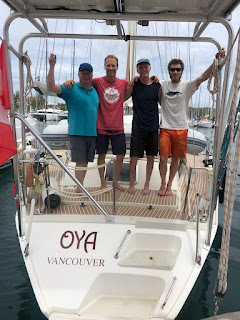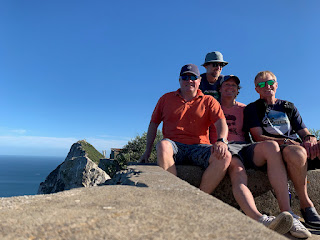We thought folks may be interested in the story of how Oyai and her crew got from Martinique to the Mediterranean. Well, get comfortable, because it's a bit of a long story (not really).
Lucky us! We have a whole year of sabbatical to play with. So if we are going to sail around the Atlantic, that means chasing the sun and avoiding hurricane season. Luckily, there is a well-travelled route that sailors take to do just that, and it goes something like this... high-tail it out of the Caribbean in May to avoid hurricanes, and head north, then east to follow the prevailing winds. Call at the Azores because its in your path on the way to Europe, then continue to where you want to go (UK, North Europe, the Med, wherever). Then, in the fall when Europe starts getting a little chilly, head south to the Canary Islands and wait until hurricane season is over. Then sail back to the Caribbean around December. This all sounded pretty dreamy to us, so that's our overall plan.
The trip from the Caribbean to Europe can be colder and stormier than the trade wind trip in the opposite direction, so our family decided that all of us would only do the return trip to the Caribbean together. For the first crossing (west to east) Stu would hire a professional skipper and find some adventurous friends to get the boat where it needed to go. Our experience with offshore sailing was pretty limited, so this seemed like the right call. Luckily, we knew a skipper by the name of Xander who is a local Comox Valley friend and he was able to fit the trip into his schedule - amazing! We also recruited two long-time friends that we used to whitewater kayak with a lot: Chuck and Mark. Xander would see us safely to the Azores, then he had to fly home. This meant that another friend and crew member, Aaron, would fly in to help us get the boat to Gibraltar. This left Stu as a somewhat reluctant skipper after we all had 17 whole days of offshore sailing under our belts.
This is the intrepid crew of 4 minutes before we shoved off from Le Marin in Martinique. From left to right is Mark, Stu, Chuck and Xander. You may notice the original name of the boat "Oya". Well, when we tried to register that name with Transport Canada, they wouldn't let us use it (maybe there was already another Oya). So, being overly practical, we simply added an "I" and "Oyai" was born! It seemed like the easiest solution because "I's" were easy to add to the name plates :)
Here, Chuck demonstrates how all of us new offshore sailors felt about the boat's movement while we were trying to cook our meals. Most of us felt pretty rough with seasickness for about 12-24 hours, but after that started to improve quickly. By day 2-3 at sea, we could cook, clean or fix things with our heads down in the bilge and we felt totally fine.
This is a video of one of our first sunsets at sea. It was our first of many!
Dolphins were our constant companions during the voyage. On almost a daily basis, they would visit us and usually play in our bow wake. It was magical to sit on the seat at the bow and have dolphins frolicking directly under your feet!
Our first we days were spent in the trade winds as we headed north. We were sailing pretty close to the wind in about 15-20 knots of wind which was pretty ideal and comfortable to break us in.
We passed many squalls (small stormy areas) and generally were able to dodge them easily. We could see them on the radar so dodging them at night time was easy too.
With Xander's guidance, we stopped the boat in the middle of the Atlantic on a very light wind day and swam in the deep blue waters. It was a bit surreal, and most of us didn't dally in the water. Looking down with mask and snorkel into the abyss was kinda crazy, and the deepness of the blue was unlike anything we had seen before.
We altered course to check out a dead whale carcass that was reported to us on VHF by a fellow sailor. It was very large and very ripe. It looked like it had died of a possible ship strike, but its hard to say for sure because it had been dead for a while. The carcass had many large bites out of the side likely from hungry sharks feeding on it. There were also live whales around the body as well.
Offshore fishing is a bit of an art form, and one that Xander was happy to share with us. We caught Mahi Mahi, and it was a real treat to have fresh fish for supper!
Land Ho! After 16 days at sea, we got our first glimpse of land. It was the Island of Faial in the Azores Island chain. This island, and its city Horta, is famous with sailors as it is usually the first land fall for eastbound sailors crossing the Atlantic Ocean.
We experienced Horta for 2 days and took in some of the local culture. The crew was well-rested and happy to be on terra firma again. Chuck, Xander, Mark and Stu walked around the town and took in many of the sights.
The Peter Cafe Sport is a famous sailing Cafe/Bar that is a must-see for any sailor crossing the Atlantic. We were having a nice meal when singing would break our spontaneously around the bar. The old salts were singing sea shanties, usually in a language we didn't understand very well.
After Horta, we sailed to the island of Sao Miguel, and tied up in Ponta Delgada which is the capital of the Azores. It had a bigger city vibe, but was still very interesting and quaint. This is where Xander left the boat, but his family flew in so they could spend a week together before heading back to Canada. We had arranged for Aaron to be the 4th crew member, and he flew in the day after we arrived and was greeted with a torrential rain storm.
With Aaron now on board, the forecast looked reasonable, so we decided to head east to finish the Atlantic crossing. It would take about 7 days to get to Gibraltar from Ponta Delgada. During that week, we would have to deal with low pressure systems, increased shipping traffic and orcas that routinely attack boats in the Straight of Gibraltar (no joke!).
About 2 days out from the Azores, we started to run into the low pressure systems and the sailing got a bit more spicy. The first system gave us winds of 25-35 knots and was just a warm up for the second system.
The next day, we were caught by the second low pressure systems and saw sustained winds of 35-45 knots for about 6 hours. We were cutting across the wind (fore reaching) to get through the weather as quickly as possible and still heading towards our destination. It was a bit tense, but the crew and boat handled things in stride. The seas eventually built up to about 4-5 meters, and the sun came out!
After the "storm", we had some work to do because some of the running rigging had come loose, so Stu went up the mast. The wind had calmed down quite a bit by this point.
While motoring at night, we approached the Straight of Gibraltar. Not wanting to tangle with any attacking Orcas, we decided to cross a shipping lane to get away from the area where the Orcas hung out. This blurry photo is of our AIS display which shows other ships around us. A LOT of other ships around us. All huge, and all going way faster than we were.
We survived the weather, the big ships, and had avoided the Orcas. Just after dawn, we got our first look at the Rock of Gibraltar, and man, did it look sweet!
The crew had some time to check out Gibraltar and see the sights on this tiny little peninsula that is so rich in history.
Our time crossing an ocean had come to an end (at least for now!). The now-seasoned crew had overcome many obstacles to successfully deliver Oyai to the Mediterranean. For that, we are forever grateful for their time and hard work. Thanks fellas! Our next Atlantic Ocean crossing will be from the Canary Islands to the Caribbean in December as a family. We will also have crew on board for that trip to lighten the load for watches, cooking, cleaning, etc.

















No comments:
Post a Comment